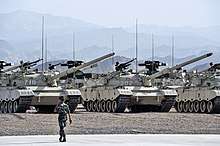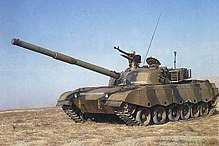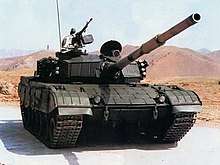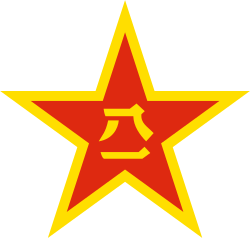Type 80/88 main battle tank
The Type 80 (Chinese: 80式; pinyin: Bālíng Shì) and the Type 88 (Chinese: 88式; pinyin: Bābā shì) are a family of Chinese second-generation main battle tanks (MBTs). They are also known as the ZTZ80 and ZTZ88.
| Type 80 | |
|---|---|
 Type 80 with 105mm rifled gun | |
| Type | Main battle tank |
| Place of origin | People's Republic of China |
| Service history | |
| In service | 1980–2005 (China) |
| Used by | See Operators |
| Production history | |
| Designed | 1970s (Type 80) 1981–1987 (Type 88) |
| Manufacturer | First Inner Mongolia Machinery Factory |
| Variants | Type 80/80-II Type 85/85-I/85-II/IIA/IIM/AP Type 88A/B/C |
| Specifications | |
| Mass | 38–39.5 tonnes |
| Length | 6.325 m (10.369m gun forward for Type 85-III) |
| Width | 3.372 m |
| Height | 2.29 m |
| Crew | 4 (3 in Type 85-IIA/Type 88C) |
| Armor | Type 80: Cast Steel Turret Type 85II/Type 88: Welded Steel/Composite Armor Turret. May be fitted with Explosive Reactive Armor |
Main armament | Type 80/85: 105mm Type 83 or 83-I rifled gun Type 85IIA/Type 88C: 125mm smoothbore gun |
Secondary armament | 7.62 mm coaxial machine gun 12.7 mm air-defence machine gun |
| Engine | Diesel (Type 88C)[1] 730 hp (544 kW) (Type 88C)[1] |
Operational range | 400 km (Type 88C)[1] |
| Maximum speed | 57.25 km/h (Type 88C)[1] |
History
In the 1970s China's primary MBT in service was the Type 59, a copy of the T-54 tank which was obsolete compared to contemporary Soviet and Western designs. The People's Liberation Army (PLA) thus requested new tanks that could match Russian designs, which led to the development of the Type 69 tank that incorporated some technologies from a captured Soviet T-62 tank. However the Type 69 failed to satisfy PLA requirements and was only an export success that saw limited domestic service.
Further tank development commenced which led to the WZ122, Type 80 and Type 90 prototypes. The Type 80 began development in 1980 under 617 Factory with 201 Institute, 447 Factory, and 616 Factory.[2] None of the prototypes entered service.
A brand new tank was designed for export based on the Type 80 chassis. It was named the Type 85 and marketed as the "Storm". However, the Storm series of tanks failed to gather interest among potential buyers. From the Type 85-IIA onwards, the tank featured an expanded, angular turret with a copy of the T-72's 125mm gun with autoloader. The Type 85-IIM variant eventually caught the interest of the Pakistani government and was exported under the designation Type 85-IIAP.
The Type 85-III was renamed the Type 88C for domestic production.[3] The Type 88C was renamed as the Type 96 and upgraded in the 1990s.
Design
The Type 80 inherited the design philosophy of the Type 69/79 which combined a Soviet style chassis and turret with Western technology. Like the Type 69 series, the initial Type 80 design possessed a hemispherical turret similar to the T-54/55. Another similarity was that the driver sat in the left forward section of the hull.[4] However, the Type 80 used a local copy of the NATO 105mm rifled gun instead of the Soviet 100mm rifled gun. It was also the first Chinese design to be observed using a system of six road wheels and three support rollers.[4] The first Chinese tanks to incorporate applique composite armor were later variants of the Type 80 family.[5]
The Type 85-I (Storm-1) series had a new welded turret design that was angular instead of the familiar bowl-shape. The Type 85IIAP/M was the first tank in the series to be equipped with a 125mm smoothbore gun.
Variants
The "M" in the designation represents a variant primarily intended for export.[6]
Type 80
Type 80
- First Chinese second generation tank design.[7] Uses an older-style round steel cast turret with new chassis.[7][8] Four-man crew.[9] Export version of Type 88.[8]
Type 80-I
- Export version. Distinguished from Type 80-II by type of 105 mm. gun mounted.[8]
Type 80-II
- Export version. Distinguished from Type 80-I by type of 105 mm. gun mounted.[8]
Type 88
Type 88
- Domestic version of Type 80. Uses an older-style round steel cast turret with new chassis.[7] Domestic version of Type 80.[8]
Type 88A
- Domestic version of Type 80-I. Export version. Distinguished from Type 88B by type of 105 mm. gun mounted.[8]
Type 88B
- Domestic version of Type 80-II. Distinguished from Type 88A by type of 105 mm. gun mounted.[8]
Type 88C
- Domestic version of Type 85-III. Uses an angular welded turret.[10] Armed with a 125 mm. smoothbore gun with an autoloader.[11] Equipped with JSFCS-212 fire control system (FCS) (with laser rangefinder, ballistics computer, stabilized gunner's sight and dual-axis gun stabilization), and Type 889B radio with range of up to 30 km.[1] Later renamed to Type 96.[10][11]
Type 85
Type 85
Type 85-I[11]
Type 85-II[11]
Type 85-IIM
- Armed with a 125 mm. smoothbore gun with an autoloader.[10][11] Three-man crew.[12] Export designation to Pakistan may be Type 85-IIA[10] or Type 85-IIAP.[11]
Type 85-III
- Upgrade for the Type 85 with 1000 hp engine, explosive reactive armour, improved FCS, and thermal night sight.[10]
 Type 88A tanks
Type 88A tanks- Storm-1/Type 85-I. Prototype designation for export. Never mass-produced. Welded turret on Type 80 chassis.
 Type 85-IIM variant with 125mm gun
Type 85-IIM variant with 125mm gun Type 85-ІІІ
Type 85-ІІІ
Operators

- 300 Type 88A/B as of 2018[13]
- 275+ Type 85 as of 2018[14]
- 10 Type 85-II-M (local designation Al-Bashir) as of 2018[15]
See also
References
- "中国陆军88C式坦克". www.people.com.cn. 16 July 2002. Retrieved 5 June 2019.
- "Type 88 Main Battle Tank - SinoDefence.com". 2010-06-07. Archived from the original on June 7, 2010. Retrieved 2015-11-03.CS1 maint: unfit url (link)
- Pike, John. "Type 85-III / Type 88C". www.globalsecurity.org. Retrieved 2017-08-06.
- "Type 80". www.globalsecurity.org. Retrieved 2015-11-03.
- "中国坦克专家谈"外贸"坦克发展". www.huaxia.com. Retrieved 2015-11-07.
- Blasko: page 123
- US Army TRADOC Intelligence Support Activity: page 5-39
- Blasko: page 124-125
- Foss: page 16
- US Army TRADOC Intelligence Support Activity: page 5-40
- Blasko: page 125
- Foss: page 14
- International Institute for Strategic Studies: The Military Balance 2018, p. 251.
- International Institute for Strategic Studies: The Military Balance 2018, p. 292.
- International Institute for Strategic Studies: The Military Balance 2018, p. 489.
- "Trade Registers". Stockholm International Peace Research Institute. Retrieved 22 April 2019.
- Binnie, Jeremy; Cranny-Evans, Samuel (27 July 2017). "Ugandan president reveals T-90 and Chinese tanks". IHS Jane's 360. Archived from the original on 27 July 2017. Retrieved 27 July 2017.
- International Institute for Strategic Studies: The Military Balance 2018, p. 493.
- Bibliography
- Blasko, Dennis J. (2006). The Chinese Army Today: Tradition and transformation for the 21st century. New York: Routledge. ISBN 9-780-415-77003-3.
- Foss, Christopher F. (2000). Jane's Tank and Combat Vehicle Recognition Guide (2nd ed.). New York: Harper Collins Publishers. ISBN 978-0004724522.
- International Institute for Strategic Studies (2018). The Military Balance 2018. Routledge. ISBN 978-1857439557.
- US Army TRADOC Intelligence Support Activity. Ground Systems. Worldwide Equipment Guide. 1 (2011 ed.). Retrieved 4 June 2019.
